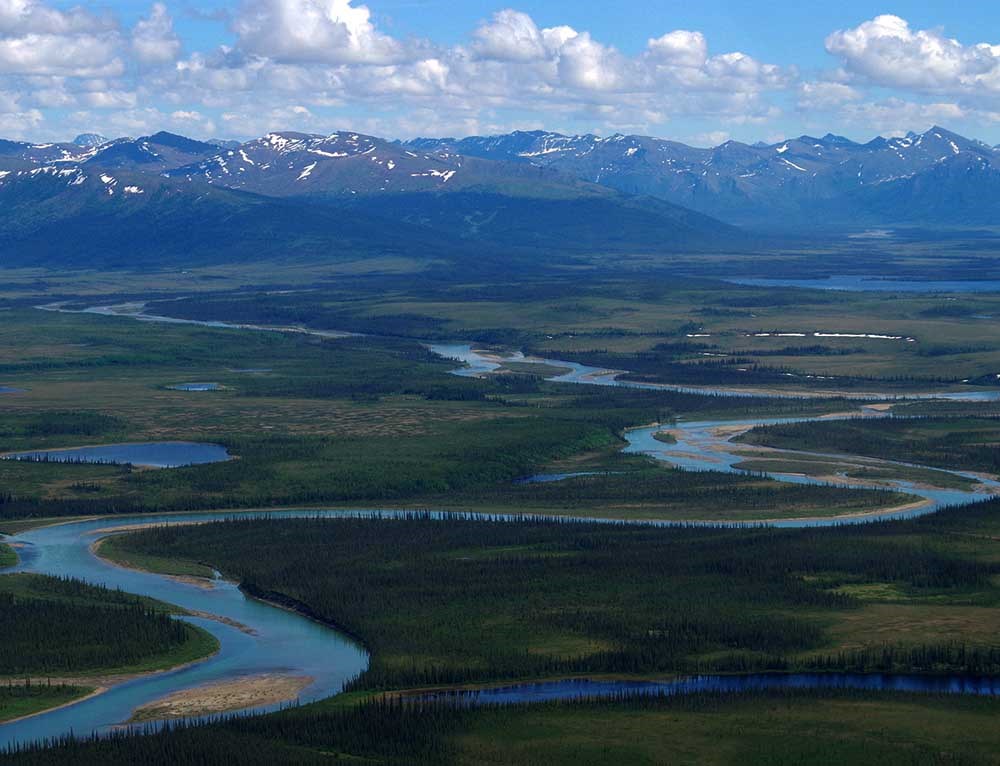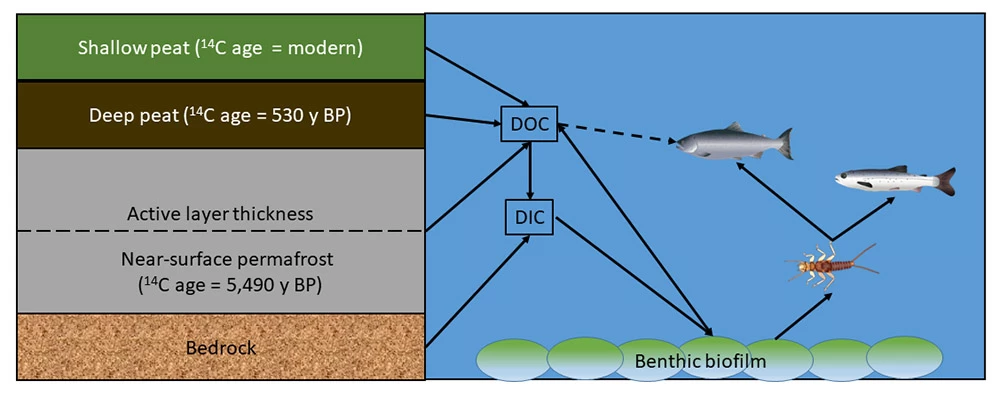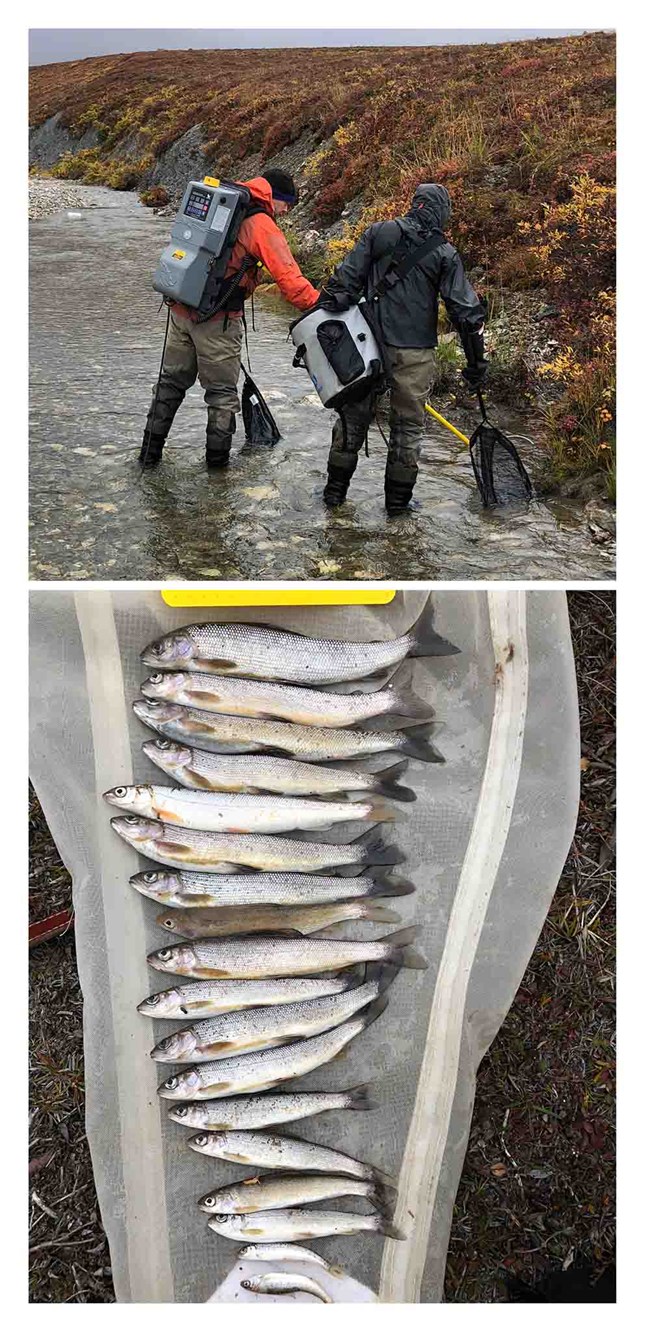Part of a series of articles titled Alaska Park Science - Volume 19, Issue 1 - Below the Surface: Fish and Our Changing Underwater World.
Article
Permafrost Carbon in Stream Food Webs of Arctic Alaska
Michael P. Carey, Josh Koch, and Christian E. Zimmerman, US Geological Survey

USGS/MIKE RECORDS
Across the Arctic, permafrost stores vast amounts of organic carbon, much of which has been kept “in the freezer” for thousands of years (Hugelius et al. 2014). When permafrost thaws, this ancient permafrost carbon can be released into the atmosphere as the greenhouse gases carbon dioxide and methane. Most research to date has focused on the release of permafrost carbon as a feedback to the Earth’s climate, which could speed up current rates of warming (Schuur et al. 2015). However, this ancient carbon can also be transported by groundwater flow and erosion from soils to streams and lakes (Aiken et al. 2014). Will this ancient permafrost carbon be transported by streams and rivers to the Arctic Ocean? Will it also be broken down by stream microbes and released to the atmosphere? How will it affect aquatic organisms, such as algae, invertebrates, and fish?
Here, we discuss some results from collaborative research conducted by a team of ecologists and hydrologists from the US Geological Survey and the National Park Service (O’Donnell et al. in press). Over the past five years, we studied these questions in the headwater basins of the Noatak National Preserve, Kobuk Valley National Park, and Bering Land Bridge National Preserve in northwest Alaska. To address these questions, we examined patterns in stream hydrology, chemistry, and biology. As the climate warms and permafrost thaws, it is expected that more of the carbon in these Arctic streams would be from the ancient stores released from thawing permafrost. Because previous studies have found that the age and chemistry of carbon in these Arctic streams varies among watersheds and across seasons (O’Donnell et al. 2014, 2016), the range of ecosystems provides a natural laboratory for examining how the contribution of ancient permafrost carbon to stream organisms varies and to explore why and how this contribution may change as permafrost thawing continues.
In twelve watersheds, we measured carbon isotopes to determine the age and sources of dissolved carbon to these streams, as well as in the stream organisms themselves, including biofilm (algae, microbes), invertebrates, and juvenile fish. While the proportion of the stable carbon isotope (13C) reflects the carbon source based on different plant types, radiocarbon (14C) reflects the “age” of the carbon, or the elapsed time since living organisms fixed carbon from the atmosphere. We understand that carbon enters the food web through lower trophic levels, like photosynthetic algae and microbial communities (benthic biofilm; Figure 1). Invertebrates then “consume” algae and microbes and, in turn, fish feed on these invertebrates. Interestingly, our 14C measurements indicated that juvenile resident fish, like Dolly Varden (Salvelinus malma) and Arctic grayling (Thymallus arcticus), use carbon that is up to 3,500 years old. Similar ages were observed in algae growing on streambed rocks and invertebrates, such as stoneflies and chironomids.


NPS/JON O’DONNELL
Based on our isotope measurements, we modeled how much fish and other stream organisms rely on old carbon from deep peat horizons (500-1500 years before present) and permafrost (>5,000 years before present) versus modern carbon (carbon captured since the 1950s in the form of leaf litter and moss). These models offered three insights. First, carbon enters the stream food web in two forms: dissolved organic carbon (DOC) used by microbes and dissolved inorganic carbon (DIC) taken up by algae. Second, nearly 80% of the stream DOC originates from the terrestrial ecosystem (not aquatic or marine ecosystems); of that terrestrial DOC, the majority is released from ancient decomposed peat and permafrost. Third, Arctic grayling and Dolly Varden incorporate both invertebrates and DOC in almost equal measure for food. However, we still need to work out the pathways of DOC movement through the food web, since fish cannot consume it directly.
Projected climate warming will likely cause widespread permafrost thaw across the Arctic (Panda et al. 2016) and with it, more ancient carbon will be released into streams (Spencer et al. 2015). Our findings indicate that as fish use more ancient carbon in their diet, it may have important consequences for fish growth. Fish that rely more heavily on ancient carbon tend to be smaller and have fewer energy reserves. Because no one understands how ancient carbon results in smaller and skinnier fish, we will need to conduct further experiments to better understand these processes. Ultimately, our goal is to forecast the long-term consequences of the increasing release of ancient carbon into our stream fishery resources.
Acknowledgements
Funding for this work was provided by the US Geological Survey’s Changing Arctic Ecosystem program and the National Park Service’s Arctic Inventory & Monitoring Network. We thank Trey Simmons and Anthony Fischbach for their helpful reviews, which greatly improved this article.
Refereneces
Aiken, G. R., R. G. M. Spencer, R. G. Striegl P. F. Schuster, and P. A. Raymond. 2014.
Influences of glacier 718 melt and permafrost thaw on the age of dissolved organic carbon in the Yukon River 719 basin. Global Biogeochemical Cycles 28: 525-537.
Hugelius, G., J. Strauss, S. Zubrzycki, J. W. Harden, E. A. G. Schuur, C. L. Ping, L. Schirrmeister, G. Grosse, G. J. Michaelson, C. Koven, J. A. O’Donnell, B. Elberling, U. Mishra, P. Camill, Z. Yu, J. Palmtag, and P. Kuhry. 2014.
Estimated stocks of circumpolar permafrost carbon with quantified uncertainty ranges and identified data gaps. Biogeosciences 11: 6573-6593.
O’Donnell, J. A., G. R. Aiken, M. A. Walvoord, P. A. Raymond, K. D. Butler, M. M. Dornblaser, and K. Heckman. 2014.
Using dissolved organic matter age and composition to detect permafrost thaw in boreal watersheds of interior Alaska. Journal of Geophysical Research: Biogeosciences 119: 2155-2170.
O’Donnell, J. A., G. R. Aiken, D. K. Swanson, S. Panda, K. D. Butler, and A. P. Baltensperger. 2016.
Dissolved organic matter composition of Arctic rivers: Linking permafrost and parent material to riverine carbon. Global Biogeochemical Cycles 30: 1811-1826.
O’Donnell, J. A., M. P. Carey, J. C. Koch, X. Xu, B. Poulin, J. Walker, and C. E. Zimmerman. In press.
Permafrost hydrology drives the assimilation of old carbon by stream food webs in the Arctic. Ecosystems 23: 435-453.
Panda, S. K., S. S. Marchenko, and V. E. Romanovsky. 2016.
High-resolution permafrost modeling in the Arctic Network of national parks, preserves, and monuments. Natural Resource Report 844 NPS/ARCN/NRR, 1366.
Schuur, E. A., A. D. McGuire, C. Schädel, G. Grosse, J. W. Harden, D. J. Hayes, G. Hugelius, C. D. Koven, P. Kuhry, D. M. Lawrence, and S. M. Natali. 2015.
Climate change and the permafrost carbon feedback. Nature 520(7546):171.
Spencer, R. G. M., P. J. Mann, T. Dittmar, T. I. Eglinton, C. McIntyre, R. G. M. Holmes, N. Zimov, and A. Stubbins. 2015.
Detecting the signature of permafrost thaw in Arctic rivers. Geophysical Research Letters 42: 2830-2835.
Last updated: June 9, 2020
